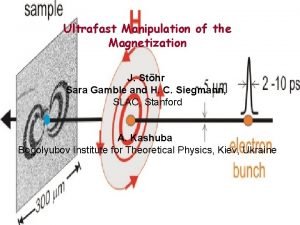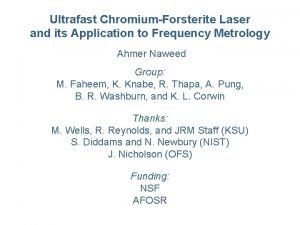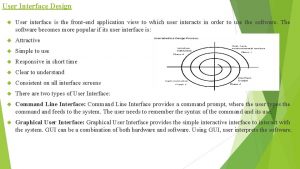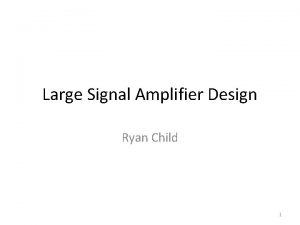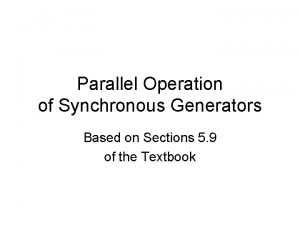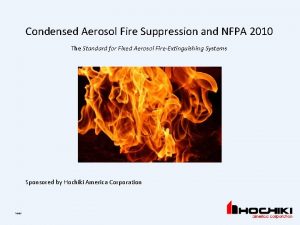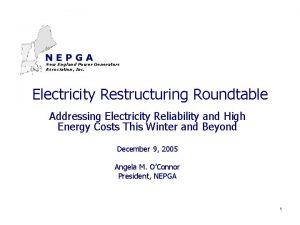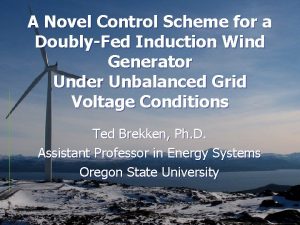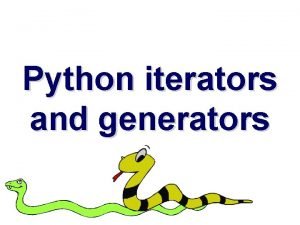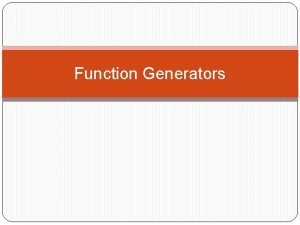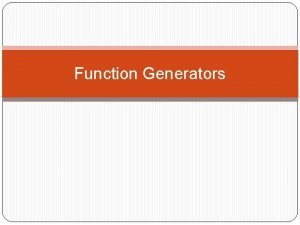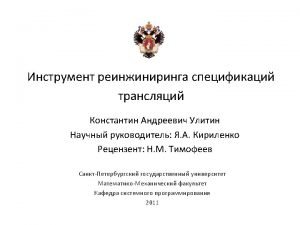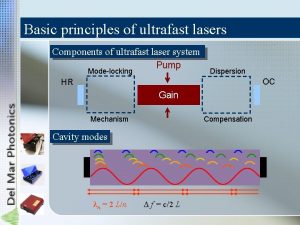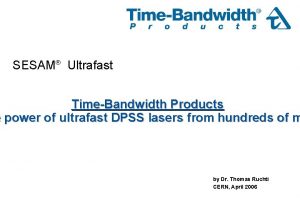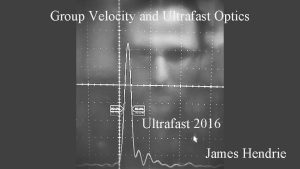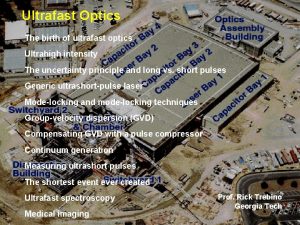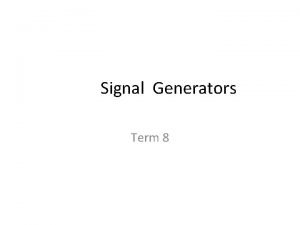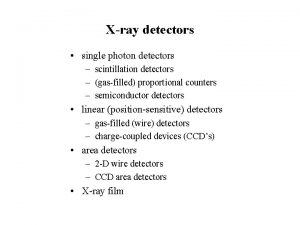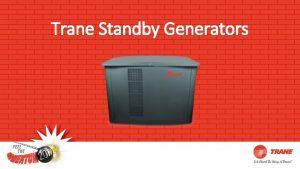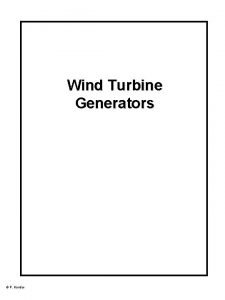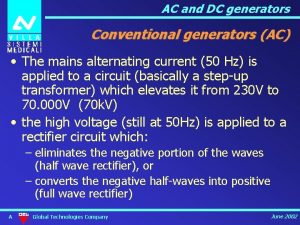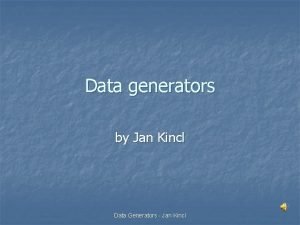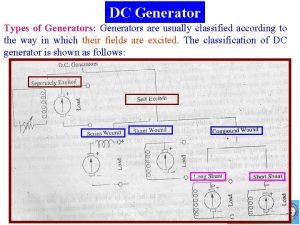Ultrafast differential frontend electronics Detectors as signal generators


























![To be decided: - with TOT ? And where ? On [E] or on To be decided: - with TOT ? And where ? On [E] or on](https://slidetodoc.com/presentation_image/2b13eabf24161445129e0f4e2bb706e2/image-27.jpg)






- Slides: 33

Ultra-fast differential front-end electronics • • Detectors as signal generators ~ Overview Low Z vs High Z Front-End Electronics (FEE), Differential vs. single ended FEE, Preliminary design & measurements G. Pascovici, IKP-Cologne, FEE Meeting, Saclay, 04 Dec. 2008

Front-end electronics – overview Detector as a fast signal generator electron-hole pairs collection only electrons (or particles) • • Front-end Electronics preamplifiers & shapers & comparators test system cooling and grounding Main requirements: • • • gain (sensibility), dynamic range (directly and/or To. T), S/N, rise/fall time and/or counting rates, crosstalk, EMI, EMC, power consumption etc. G. Pascovici, IKP-Cologne, FEE Meeting, Saclay, 04 Dec. 2008

Detector Signal Collection Circuit High Z Low Z + - Rp • Impedance adaptation • Amplitude resolution • Time resolution • Noise cut Voltage source Zo Z Low Z T Francis ANGHINOLFI ELEC-2005 Electronics in High Energy Physics Winter Term: Introduction to electronics in HEP Quo vadis ? Low Z output voltage source circuit can drive any load Output signal shape adapted to subsequent stage (ADC) Signal shaping is used to reduce noise (unwanted fluctuations) vs. signal

Front-end electronics – overview Detector as fast signal generator electron-hole pairs collection only electrons (or particles) if Z is high charge is kept on capacitor nodes and voltage builds up (until capacitor is discharged) + Rp Z • - excellent E resolution - friendly pulse shape analysis • Detector FEE (Input stage) Advantages: Disadvantages: - channel-to-channel crosstalk - pile up above 40 k c. p. s. - sensitivity to e. m. c. G. Pascovici, IKP-Cologne, FEE Meeting, Saclay, 04 Dec. 2008

Front-end electronics – overview Detector as fast signal generator electron-hole pairs collection only electrons (or particles) if Z is low charge flows as a current through the impedance in a short time. + Rp Z • - limited signal pile up - limited channel-to-channel crosstalk - low sensitivity to parasitic signals - good timing resolution - • Detector FEE (Input stage) Advantages: Disadvantages: - pour signal/noise ratio G. Pascovici, IKP-Cologne, FEE Meeting, Saclay, 04 Dec. 2008

MRCP detectors for LHC

Front-end electronics – overview Detector as fast signal generator electron-hole pairs collection only electrons (or particles) if Z is low charge flows as a current through the impedance in a short time. • Advantages: - limited signal pile up - limited channel-to-channel crosstalk - low sensitivity to parasitic signals - good timing resolution Single ended structure • Disadvantages: - pour signal/noise ratio

Front-end electronics – overview Specifications: - Fully differential transimpedance - 0. 18µm standard CMOS techn. - 10 GHz bandwidth - dynamic range 25 µA -2. 5 m. A - power consumption 88 m. W (2 V) -

Charge Sensitive Preamplifier Active Integrator (“Charge Sensitive (Pre)Amplifier”) • • • Input impedance very high ( i. e. NO signal current flows into amplifier), Cf (Rf) feedback capacitor (resistor) between output and input, very large equivalent dynamic capacitance, sensitivity A(q) ~ q / Cf, large open loop gain Ao ~ 10, 000 - 150, 000 Ci ~ “dynamic” input capacitance Rf G. Pascovici, IKP-Cologne, FEE Meeting, Saclay, 04 Dec. 2008

Standard Charge Sensitive preamplifiers developed at IKP Cologne et al. Main achievements: • • low noise, fast preamplifiers (segmented HP-GE & DSSSD) clean transfer function pulse shape …(no over/under-shoots) differential outputs for HP-Ge detectors & DSSSD-Si high dynamic range highly accurate spectroscopic TOT method (up to ~200 Me. V) incorporated programmable pulser (50 ppm long term) cryostat wiring (cold part), crosstalk less then 10 -3 miniature, SMD technology Who are our main users? - large arrays of segmented HP-Ge detectors : Miniball (CERN), Rising (GSI), Se. Ga (MSU), Tigress (Triumf), AGATA (EU) - DSSD Si detectors: Lu. Sia (Lund, GSI), Miniball@IKP, LYCCA (GSI)… G. Pascovici, IKP-Cologne, FEE Meeting, Saclay, 04 Dec. 2008

Miniball He. Ko basic structure Advantages: - discrete electronic components (e. g. HEMT, Ga. As, Si. Ge) - can be easily integrated, - flexible open loop gain, - frequency compensation vs. detector unfriendly wiring Disadvantages: - to low open-loop gain - larger size G. Pascovici, IKP-Cologne, FEE Meeting, Saclay, 04 Dec. 2008

LYCCA CSPs Charge Sensitive Loop - basic structure Advantages: - the use of advanced current feedback operational amplifier, - very fast, - compact, small size, low PS Disadvantages: - to large open-loop gain, - limited frequency compensation vs. detector unfriendly wiring G. Pascovici, IKP-Cologne, FEE Meeting, Saclay, 04 Dec. 2008

GALI -S 66 (GSI) G. Pascovici, IKP-Cologne, FEE Meeting, Saclay, 04 Dec. 2008

AGATA Single & Dual Gain Core reworked frequency compensations internal network compensation Lead comp. (1. Op. Amp) Cryostat wiring as part of the front-end electronics - minimum Miller effect (min. ) - lead compensation (min. ) - lead-lag compensation (adj. ) - dominant pole compensation (adj. ) external network compensation

LYCCA CSPs (32 - channels) block diagram - basic structure Input: 68 x high density flat band cable (SE*GND) Output: 32 x Differential 100 Ohm*, 68 x high density flat band cable x 32 channels G. Pascovici, IKP-Cologne, FEE Meeting, Saclay, 04 Dec. 2008

LYCCA - CSPs Transfer Function a) energy channel (differential out. ) tr ~ 18 ns (Gain x 1; Cd~10 p. F) tr ~ 29 ns (Gain x 3; Cd~10 p. F) b) up-graded time channels (also with differential outputs) tr ~ 200 p. S (tentative) LYCCA CSPs 200 Me. V & 4 Ge. V 32 channels only with energy diff. outputs or 16 channels with both, energy and ultra fast diff. outputs mean min max

Sub - nanosecond CSP • Ga. As – HEMT (Q 1, Q 2) • ultra-fast, narrow time output (note: measured with existing scopes: tr ~ 500 ps, expected tr ~ 200 ps !) • energy output tf~10 µs (no P/Z cancellation) • high counting rates timing > ~1 Mcps • • dominant pole compensation included low power, only +/- 6 V E +/- 3 V T) G. Pascovici, IKP-Cologne, FEE Meeting, Saclay, 04 Dec. 2008

LYCCA CSP modified for fast timing outputs: j. FET: Bf 861; BF 862, FET: BF 988 HEMT: ATF-55143 Id ~ from 2 m. A – 10 m. A

tr ~ 720 ps j. FET, HEMT selection a) j. FET, FET - BF 861 (1, B, C); BF 862; BF 889 b) Ga. As-FETs (E-p. HEMT) - ATF-35143; ATF-55143; ATF-38143 c) Idrain, Vdrain to optimize the d) noise & bandwidth characteristics e) (10 -15 m. A, 2 -2. 7 V, 20 -30 m. W) tr ~ 930 ps Pulse generator: Tektronix PG 502 modified (less than 700 ps rise/fall time) Scope: Tektronix TDS 3032 (300 MHz, 2. 5 GHz sampling)

j. FET, HEMT selection tr ~ 505 ps a) j. FET, FET - BF 861 (1, B, C); BF 862; BF 889 b) Ga. As-FETs (E-p. HEMT) - ATF-35143; ATF-55143; ATF-38143 c) Idrain, Vdrain to optimize the d) noise & bandwidth characteristics e) (10 -15 m. A, 2 -2. 7 V, 20 -30 m. W) Pulse generator: tr ~ 499 ps Tektronix PG 502 modified (less than 700 ps rise/fall time) Scope: Le. Croy 44 Xs (400 Mhz, 2. 5 GHz sampling)

j. FET, HEMT selection tf ~ 498 ps a) j. FET, FET - BF 861 (1, B, C); BF 862; BF 889 b) Ga. As-FETs (E-p. HEMT) - ATF-35143; ATF-55143; ATF-38143 c) Idrain, Vdrain to optimize the d) noise & bandwidth characteristics e) (10 -15 m. A, 2 -2. 7 V, 20 -30 m. W) Pulse generator: tf ~ 498 ps Tektronix PG 502 modified (less than 700 ps rise/fall time) Scope: Le. Croy 44 Xs (400 Mhz, 2. 5 GHz sampling) G. Pascovici, IKP-Cologne, FEE Meeting, Saclay, 04 Dec. 2008

• Read-out from a MCP + dual delay line based position sensitive detector • Two mutually perpendicular delay lines * - Sobottka & Williams, IEEE Trans. NS (1988), 35, p 348 - Kozulin, Kondratiev et al. , Nucl. Exp. Tech. , 2008 No 58, p. 44 -58 Preliminary design - test measurements

Read-out from a MCP-based position sensitive detector LT 6411 • 3300 V/µs • 650 MHz • 50 -100 m. W / ch. G. Pascovici, IKP-Cologne, FEE Meeting, Saclay, 04 Dec. 2008

LYCCA CSPs (32 - channels) block diagram - basic structure Input: 68 x high density flat band cable (SE*GND) Outputs: 32 x E - differential 100 Ohm*, 68 x high density flat band cable x 32 channels G. Pascovici, IKP-Cologne, FEE Meeting, Saclay, 04 Dec. 2008

LYCCA like CSPs with implemented ultra-fast differential time outputs – 16 x channels Input: 68 x high density Outputs: 16 x [E] ch. - differential 100 Ohm*, flat band cable (SE*GND) 32 E out of 68 x high density flat band cable (10µs) (a) Diff. Comp. CML, LV-PECL, LVDS (b) tf ~10 ns* (opt. ~ 100 ns) x 16 channels Outputs: 16 x [T] ch. - differential 100 Ohm*, 32 T out of 68 x high density flat band cable G. Pascovici, IKP-Cologne, FEE Meeting, Saclay, 04 Dec. 2008

To be decided: - with TOT ? - with spectroscopic TOT ? - differential signals standard: PECL, NECL, CML ?
![To be decided with TOT And where On E or on To be decided: - with TOT ? And where ? On [E] or on](https://slidetodoc.com/presentation_image/2b13eabf24161445129e0f4e2bb706e2/image-27.jpg)
To be decided: - with TOT ? And where ? On [E] or on [T] channel ? - with spectroscopic TOT ? Or quasi spectroscopic? - differential signals standard: PECL, NECL, CML ? TOT circuitry? - requirements has to be decided ? -E or/and T ch. ?

Ga. As(HEMT) +Transimpedance preamplifier-amplifier ~450 m. W/ch + j. FET 1 or 2 stages Ga. As(HEMT) +Si-Ge amplifier+ Si-Ge ultrafast comparator ~60 m. W/ch + j. FET

Potential solution with “motherboard” LYCCA architecture (8 -16 channels) Potential solution without “motherboard” Input Output architecture (2 - 4 channels) Ch 1 - timing Ch. 1 input Ch. 2 input Ch 2 - timing Advantages: • very fast • compact, small size • low PS (450 m. W/ch) • cooling in vacuum (~ 2 D structure) • no motherboard architecture • impedance matching for UHF Ch. 1 output Ch. 2 output Disadvantages: w. motherboard no motherboard - power consumption in vacuum ? - motherboard architecture - impedance matching for UHF ? • solution only for small number of channels, • distribution of infrastructure signals (PS, adj. )

• Sensitivity: A(t) ~100 m. V/10 f. C slope: Timing jitter [ walk ] dynamic range, even for constant rise/fall times Intrinsic jitter Ratio: amplifier rise time/ collection time • CFD, ELD (extrapolated leading edge), ARC • correlated 2. channel [ jitter ] ó intrinsic noise, ó intrinsic jitter • noise distribution • bandwidth • intrinsic jitter • BW[Hz] bandwidth, Nd ~spectral density • noise dispersion M. Ciobanu et al, A FEE card comprising a high-gain • intrinsic time resolution amplifier and a fast discriminator for TOF measurements

IE 1 I+IE 2 I


Electronic Design, Vol. 46, No. 25, 1988 LVDS, CML differential interfaces common-mode range compared to single-ended noise margin. The effective noise margin is 2 to 4 times better using LVDS, CML…
 Ultrafast magnetism
Ultrafast magnetism Ultrafast
Ultrafast Ultrafast demagnetization
Ultrafast demagnetization Photo detectors
Photo detectors Feature vectors
Feature vectors What is thermal detector
What is thermal detector Nuclear detectors
Nuclear detectors Feature detectors
Feature detectors What is streaming potential
What is streaming potential Where are feature detectors located
Where are feature detectors located Giant wave detectors murmurs universe
Giant wave detectors murmurs universe Chromatography mobile phase and stationary phase
Chromatography mobile phase and stationary phase Frontier detectors for frontier physics
Frontier detectors for frontier physics Vhv voltage detectors
Vhv voltage detectors Feature detectors ap psychology
Feature detectors ap psychology Giant gravitational wave detectors hear murmurs
Giant gravitational wave detectors hear murmurs Yodsawalai chodpathumwan
Yodsawalai chodpathumwan Difference between front end and back end languages
Difference between front end and back end languages Flexbox vs bootstrap
Flexbox vs bootstrap User interface analysis
User interface analysis 010001011
010001011 Api frontend backend
Api frontend backend Signal amplifier
Signal amplifier Baseband signal and bandpass signal
Baseband signal and bandpass signal Digital signal as a composite analog signal
Digital signal as a composite analog signal Even part of signal
Even part of signal Baseband signal and bandpass signal
Baseband signal and bandpass signal Parallel operation of synchronous generator
Parallel operation of synchronous generator Good poem generator
Good poem generator Nfpa 2010 aerosol extinguishing technology
Nfpa 2010 aerosol extinguishing technology Abb ability smart sensor
Abb ability smart sensor New england power generators association
New england power generators association Wind generators
Wind generators Python iterators and generators
Python iterators and generators
